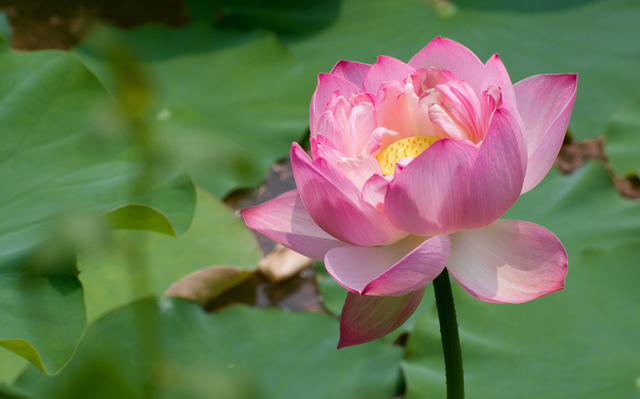The sacred lotus: The answer to garden midsummer blues
Those who plant the sacred lotus in their garden will get a whole second summer, says Mark Griffiths


A month ago, I thought I was in for a bout of midsummer blues. It’s a common complaint among gardeners, the sense that, come the solstice, the best is behind us. In June, our gardens are at their most romantic and quintessentially English, but, like their signature roses, their bloom is all too soon blown. Of course, there’s much more to come—not least, a veritable prairie of ornamental grasses and late-flowering perennials— but their Indian summer still seems an age away.
The remedy through July has been our sacred lotuses (Nelumbo nucifera), which only recently decided that summer had truly begun and that it was going to be an exceptional one. They sit against our sunniest house wall in large bowls filled two-thirds deep with heavy loam and topped up with rainwater.
In April or early May, we replant their rhizomes, which have passed the winter leafless, dormant and damp in frost-free storage. The bowls then go outdoors, but are sheltered inside a tent made for grow-bag tomatoes, until temperatures soar—and the new leaves with them.
Once this happens, feeding begins—every three weeks, with that fine old fertiliser of fish, blood and bonemeal, mixed with wet soil and rolled into cherrysized balls; three to five balls per bowl, pushed deep into the loam. At least once a week, they’re also given a shower heavy enough to make them overflow. It’s a palaver, I’ll admit, but worth it. This becomes clear as you watch water droplets dancing off the lotuses’ parasol foliage, their dream-like flowers expanding with the sunrise and (key for dispelling midsummer blues) the sheer energy of their shooting, which takes off just when more familiar beauties have become weary.
The time of the sacred lotus
In Japan, the period from mid July through August is known as the Time of the Lotus, a happier name than our own dog days. It’s a sweltering period of phenomenal growth, gargantuan foliage and exuberant colour; a botanical carnival when gardeners take a holiday from decorum and design, marvelling at prodigies instead.
There’s much to be said for this second summer, whose outlandish luxuriance, in a matter of days, makes the garden a foreign place. In ours, it conjures colossal leaves from a spring-pollarded Paulownia tomentosa and eruptions of felt-gloved dragon’s paws from Tetrapanax Rex. It launches Musa basjoo with watchable speed, turning this banana’s paddles into a shelter from downpours and the perfect spot to listen to their drumming.
Exquisite houses, the beauty of Nature, and how to get the most from your life, straight to your inbox.
Nearer the ground, it makes rare marriages of colour and texture: the ruby daylily Hemerocallis Pardon Me radiant against phosphor- green pillows of Soleirolia, turquoise Hosta Halcyon cheek to cheek with Begonia Claret Jug, a hardy but late-sprouting cultivar whose semi-lucent leaves are satiny khaki above and conspicuously blood red beneath.
These species are mostly of Far Eastern origin, but, as you’d expect of a carnival, Central and South Americans also play their part. Dahlias, for example, aren’t that much less bother than lotuses to get growing well. This year, we’ve gone big with buttermilk Dahlia Café au Lait and bizarre with Tamburo (velvety purple-black) and Imagion (white flecked with raspberry).
Imagion is outdone in chromatic craziness by Mirabilis jalapa, the Marvel of Peru, whose flowers are simultaneously magenta, white, yellow, orange and mixtures thereof. In the late 16th century, this bushy, tuberous perennial was the unlikely acme of English horticultural chic. I wanted to see what kind of dash it would have cut among antique roses and pinks, which is how it ended up in our garden.
I’d missed the point: it flowers later than they do, hence part of its value for our Elizabethan forebears. Still, here it remains, loud and loutish by day, enchanting at dusk when its tutti-frutti flutes unfurl, emit their Chablis-sharp perfume and summon moths like a spotlight. It’s a strange spectacle, but magical. Typical, in fact, of the Time of the Lotus.
The Lotus Quest by Mark Griffiths is published by Chatto & Windus at £20
* Follow Country Life magazine on Twitter
-
 All fired up: 12 of our favourite chimneys, from grand architectural statements to modest brick stacks, as seen in Country Life
All fired up: 12 of our favourite chimneys, from grand architectural statements to modest brick stacks, as seen in Country LifeNothing says winter like a roaring fire, and plenty of the houses that we've photographed for the magazine's architectural places have fireplaces and chimneys worth boasting about.
-
 What is everyone talking about this week: More than half the country owns a pet and nearly half our marriages end in divorce — no wonder pet-nups are on the rise
What is everyone talking about this week: More than half the country owns a pet and nearly half our marriages end in divorce — no wonder pet-nups are on the risePet-nups, a formal agreement between couples over what should happen to their pets in the event of a split, are on the rise.
